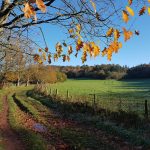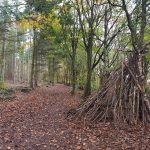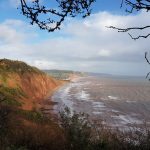Dartmoor and Exmoor
We have to start with Devon’s two moors: Exmoor and Dartmoor. We’ve written lots about these before, but the rocks and valleys of the moors change throughout the seasons, so there’s always something new to discover. Dartmoor, with its vast open panoramas has hundreds of miles of footpaths. Visit the stunted oaks of Wistman’s Wood for a remote and mysterious fairytale woodland setting. The moss-covered landscape really sparks the imagination: there could be a hobbit hiding behind any rock! The nearest town to Wistman’s Wood is Princetown on the High Moor. Of all the places in Devon, it is one of the most likely to get snow. When the temperature drops, even if it’s raining by the coast, it can be snowing on the moor. Princetown’s visitor centre is a great starting point for discovering the wild moor and its stories. You can check the state of the weather before you set off by checking on the Dartcam.
On a crisp, bright winter’s day, Tarr Steps is idyllic. There’s a gentle walk from the car park down to the ancient clapper bridge, composed of huge stone slabs, from where you can then go on to explore the beautiful wooded valley of the River Barle.
The Killerton Estate
The National Trust’s Killerton House and Gardens are well-known and they publicise their seasonal walks on their website. The easy one-hour winter walk takes in the quaint chapel. However, the Killerton estate also includes some other nearby locations that you might not have heard of. Danes Wood is a short distance from Killerton House. From the car park, you can complete a shorter or slightly longer circular walk. Great for small children, the wood is well known for its wildlife – keep an eye out for buzzards and other birds – and often has a rope swing or two hooked up in the trees.
East Devon Pebblebeds
Part of the East Devon Pebblebed Heaths, the heathland of Woodbury Common is a haven for walkers and cyclists. Park at the iron age castle – the ancient ramparts are still clearly visible – then walk through the woods towards the sea, past the military firing range (don’t worry they fly a red flag on firing days!) and then back up the hill. You’ll have a good views of the sea along the way. Nearby Aylesbeare Common is a must for bird watchers. In the winter, keep an eye out for snipes and winter thrushes.
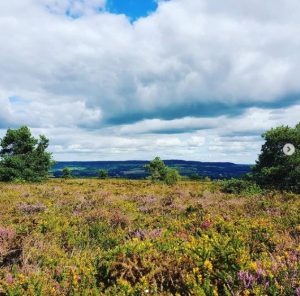
Close to Forest Glade
A ten minute drive from Forest Glade, Hembury Fort is another ancient hill fort. Privately owned, but open to walking visitors, it has been the site of lots of archaeological investigation. There’s an information board on the way in. Another easy, fairly short walk, suitable for children, venture along the tree-lined banks up to the top of the fort for stunning views.
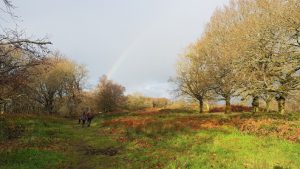
The Coast
There’s something particularly fortifying about walking by the sea in winter time. The calm lapping waves of summer give way to a more ferocious, stormy swell. Pick any part of the South West coast path for an invigorating stroll and take in the fresh ozone-laden air. If you prefer walking down on the sand, we recommend the length from Orcombe Point at Exmouth, along the beach to the Marina at the opposite end of the sea front. There are plenty of places to buy warming food and drinks along the way.
If you find a winter walk that you’re particularly fond of, be sure to let us know so that we can share it with future guests.



